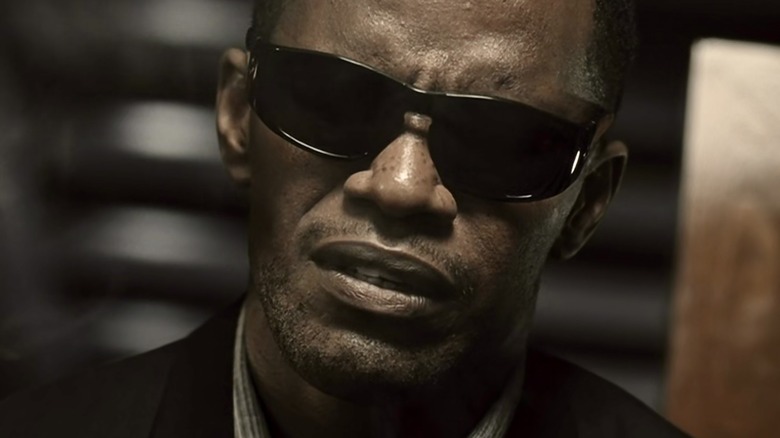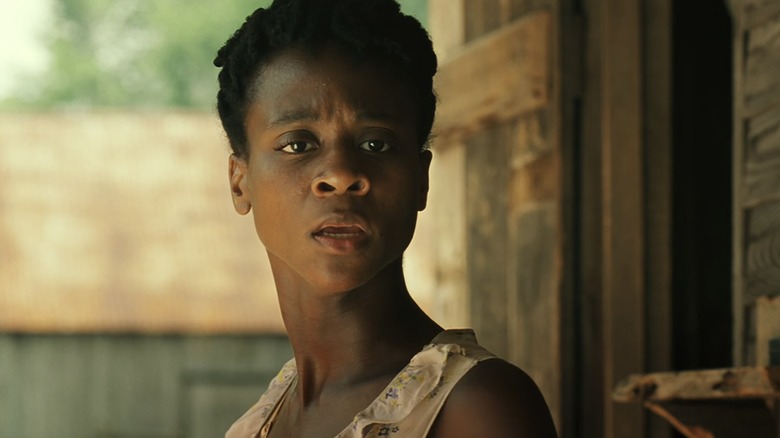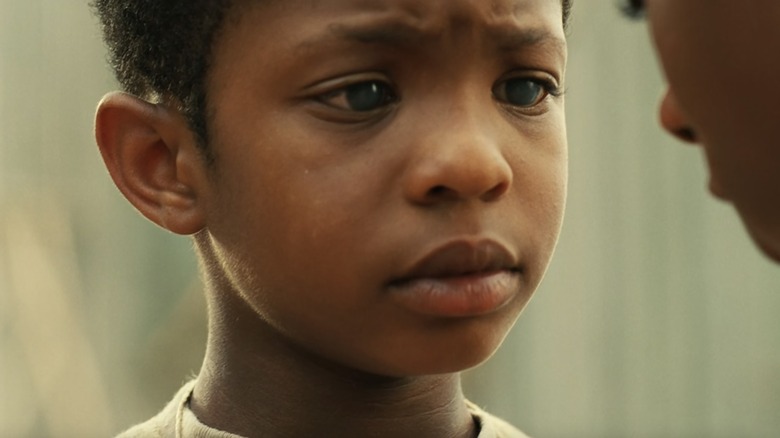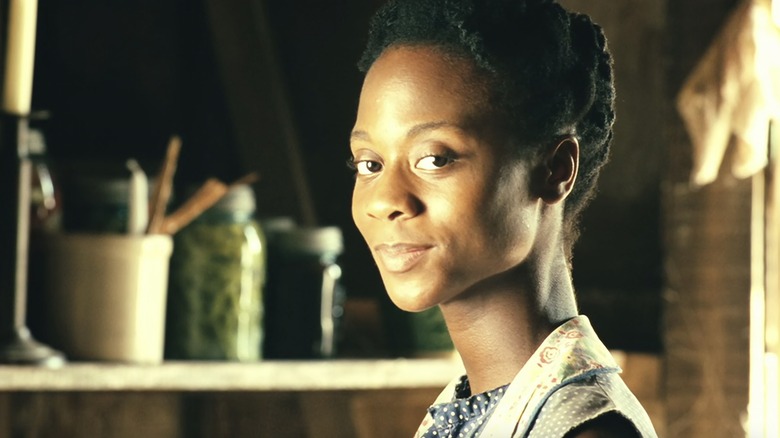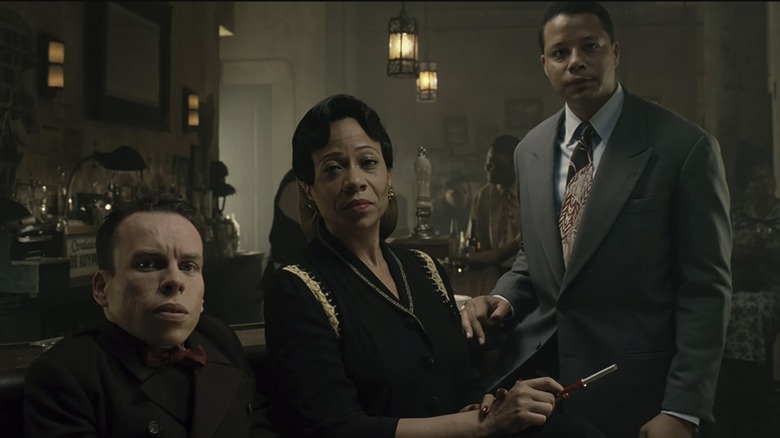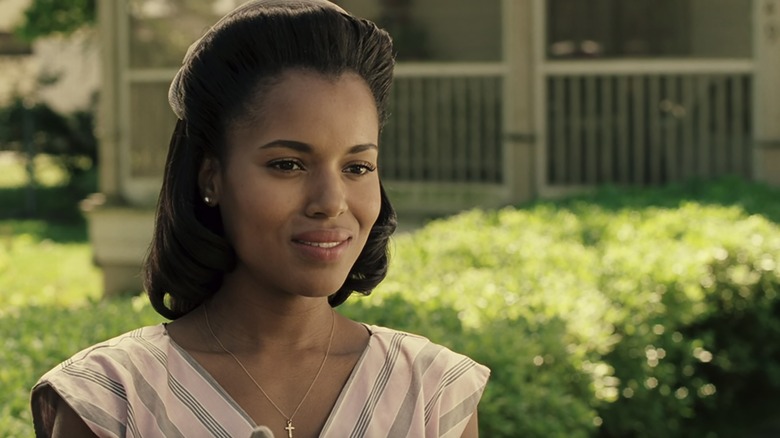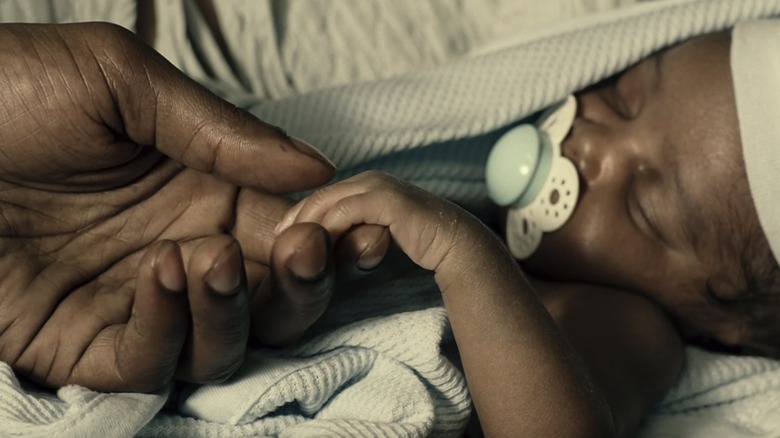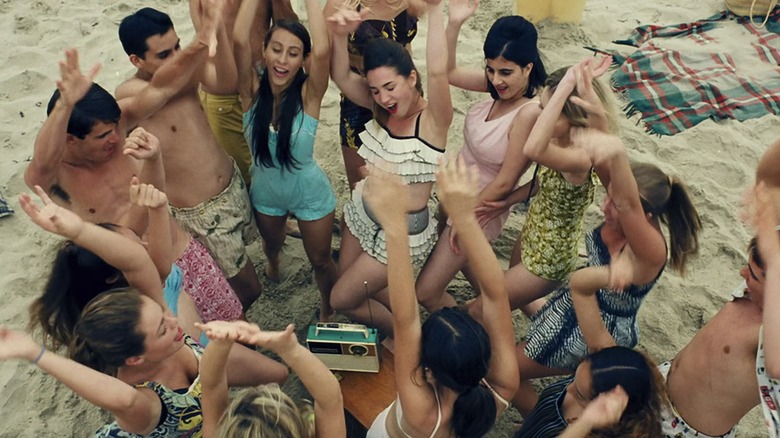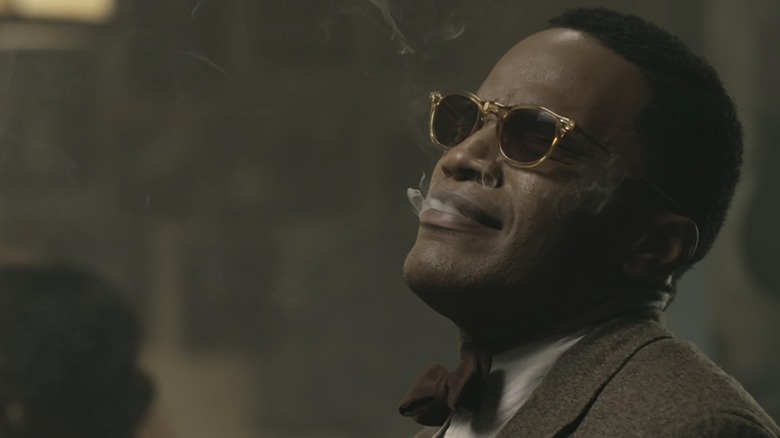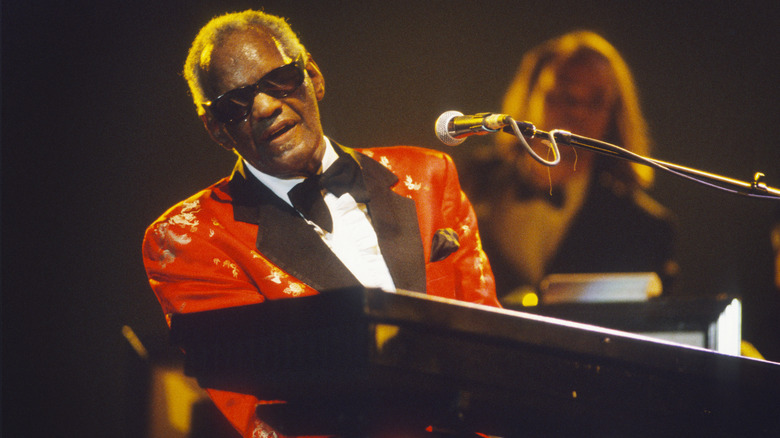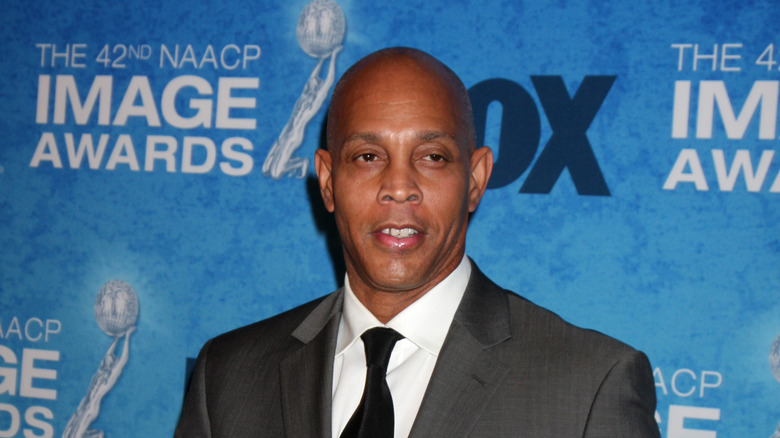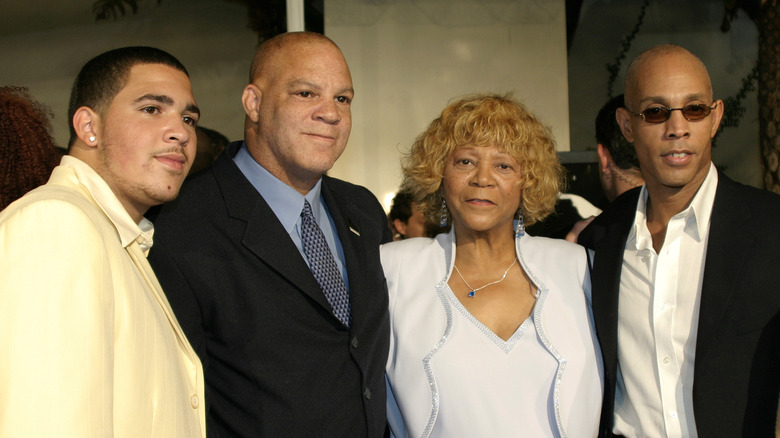Everything Ray Doesn't Tell You About The True Story
Ray Charles was a music legend. After Frank Sinatra called Charles "the only true genius in our business," the nickname "The Genius" stuck for the rest of his life (per The Independent). He's often credited with inventing soul music when he married gospel and blues, creating his signature sound that took the charts by storm in the '50s and '60s. Charles crossed genres, masterfully playing R&B, jazz, country, and soul, bringing his fans along for the ride. As Billy Joel once famously said, "This may sound like sacrilege, but I think Ray Charles was more important than Elvis Presley" (via The Tampa Bay Times).
Charles' life story is rife with drama, from his humble beginnings to his wide-ranging music career, from his family life to the struggles with addiction that led to a career-endangering arrest for possession in the mid-'60s. All of these are explored in the Oscar-winning biopic "Ray," starring Jamie Foxx in the titular role. Although "Ray" doesn't skirt Charles' more controversial choices, eccentricities, and mistakes, it does (as David Ritz wrote for Slate) sentimentalize his real life. "Ray" is an excellent movie about music, but like any movie based on a true story, you might feel compelled to dig a little deeper. Keep reading if you want to discover everything "Ray" doesn't tell you about the true story of Ray Charles.
Ray actually had two mothers
Ray Charles Robinson had two mothers. His biological mother, Aretha Williams, was depicted in the film, but there was also his father's first wife, Mary Jane Robinson. Both women had a huge influence on him as a child. As David Ritz, co-author of Ray Charles' 1978 autobiography "Brother Ray," shared in a Slate article, "After her 6-year-old son went blind, Aretha fostered his independence, while Mary Jane indulged him. For the rest of his life Ray was as fiercely self-reliant as he was self-indulgent."
The specific reasons "Ray" didn't include both women in the film remain a mystery, though it's not entirely surprising. Trying to condense decades into a biopic requires eliminating extraneous characters and streamlining events into a tight narrative audiences can follow. Biopics are notorious for employing creative license to simplify storylines, increase drama, and create a satisfying narrative arc for the central figure. It is also possible Charles' second mother was eliminated because of the circumstances of his birth.
Mary Jane and Bailey Robinson took Aretha in as an orphaned teenager. Soon, Aretha was pregnant with her foster father's child. Because of the scandal this pregnancy created in their community, Aretha was sent away and gave birth to Ray on Sept. 23, 1930, in Albany, Georgia. The Robinsons separated after Ray was born and Bailey wasn't involved in raising his son. Aretha wanted her son to be independent despite going blind from undiagnosed glaucoma at seven years old, as Irene Earls documented in her book, "Young Musicians in World History."
The film ignores Charles' education at a state-run school
We see Aretha and Ray saying a tearful goodbye in "Ray," but the film doesn't explore his time as a student. Although she was illiterate and couldn't fill out the application herself, Aretha found a state-run school for the deaf and blind in St. Augustine, Florida. The state covered the costs of his education and train fare home for visits. It was at the school that a young Ray Charles Robinson (he dropped Robinson when he started playing professional gigs) decided he wanted to be a musician and dedicated himself to his studies (via "Young Musicians in World History").
Charles learned to play classical piano and to read and compose music in braille, and learned to score music for big band ensembles. Besides the piano, Charles learned to play sax, clarinet, trumpet, and organ while attending school. Although they focused on teaching classical music, Charles loved legendary jazz musicians like Artie Shaw, Duke Ellington, and Count Basie. Charles didn't have many friends at school, so he spent his nights listening to the radio and expanding his musical knowledge. He enjoyed the Grand Ole Opry, gospel, and blues (per SwingMusic.net).
The Florida School for the Deaf and the Blind is a unique educational institution that was established in 1885. It's one of the top schools for deaf and blind children in the United States, and is the only tuition-free educational institution of its kind in Florida. Without this tuition-free school and the incredible education he received while attending, the world may have never known his musical genius.
Ray might disagree with the film about what trauma shaped him most
The film "Ray" suggests that Charles was traumatized by witnessing the drowning death of his younger brother George when he was only five years old. In several sequences throughout the film, Ray has nightmarish hallucinations of water. This dramatization suggests the trauma of seeing George die was a contributing factor leading to Charles' addiction to heroin. Watching his brother die must have been traumatic, but there's no evidence Charles actually experienced these hallucinations.
It is well documented that childhood trauma can contribute to adult addiction (via The National Library of Medicine), but "Ray" simplifies Charles' life story, blaming his struggles with addiction mainly on this one experience. Charles' childhood was rife with traumatic experiences. In his autobiography "Brother Ray," Charles comments on the severity of the poverty he grew up in, writing, "Even compared to other blacks ... we were on the bottom of the ladder looking up at everyone else. Nothing below us except the ground."
Although going blind must have been emotionally trying, according to Charles, the first time he experienced something that could be described as a breakdown was when his mother, Aretha, died. Charles told biographer David Ritz (via Slate), "It's the death of my mother Aretha, that had me reeling. For days I couldn't talk, think, sleep or eat. I was sure-enough going crazy." It is clear from the film, he doesn't want to talk about his mother's death, but "Ray" misses an opportunity to explore Charles' inner world by avoiding this formative experience.
Ray left school at 15 after his mother's death
Distraught over his mother Aretha's death, Ray Charles left school at 15 to work as a professional musician (per The Washington Post). According to the book "Ray Charles" by Norman Winski, Charles then moved to Jacksonville, Florida, where he joined a musicians' union while rooming with a kind older couple, the Thompsons. During this period, Charles traveled as a road musician on the chitlin circuit in the southern states, as depicted during flashbacks in "Ray."
When Charles got on a Greyhound Bus headed to Seattle, as depicted in the film, he was still a teenager. Contrary to what they depicted in the film, the woman he roomed with after arriving in Seattle was not his manager, nor did she take advantage of him in a sexually predatory relationship. According to The Seattle Times, Charles rented a room with Georgia Kemp when he arrived, and later he lived with his girlfriend Louise, who moved west from Florida to meet him.
Writer-director Taylor Hackford included a predatory manager and bandmate to give Ray the impetus to strike out on his own, becoming an independent musician. As reported by The Seattle Times, Garcia McKee, Charles' musical partner who also moved from Florida to Seattle, didn't steal from Charles. McKee was simply paid more because he was the bandleader, and union contracts paid bandleaders more than musicians. Although Charles wasn't cheated by McKee or an agent in Seattle, dishonest agents and record labels were common, as explored in other biopics like "Cadillac Records" and "Elvis."
Ray Charles was married twice
Although we only see Ray Charles get married once in "Ray," he was actually married twice. His first marriage, to Eileen Williams, lasted less than a year (per Rare). As depicted in the film, Charles and Della Beatrice Howard met in Texas in 1954, and they were married the next year. The film depicts their relationship without shying away from their arguments about his drug use and infidelity, or dodging the reality of their struggles as a couple. Still, "Ray" makes it seem like Della and Ray got a second chance at love after he kicked heroin, showing Della and their three children attending the 1978 ceremony declaring "Georgia on my Mind" the official state song.
In his Slate article, Charles' biographer David Ritz criticizes the movie's formulaic happy ending, because it obscures a much more interesting and truthful reality. After kicking heroin, Charles toured extensively and continued having affairs on the road. This led to Charles and Della divorcing in the late '70s. In 1978, Charles published his autobiography, "Brother Ray," in which he talked openly about his infidelity and his inability to control his attraction to women. A Jet article from 1978 about Charles' book details how he admitted to being "hooked" on women, writing, "My obsession centers on women — did then (when young) and does now. I can't leave them alone."
Ray reportedly had 12 children
Although "Ray" doesn't shy away from depicting its subject's affairs, the film only acknowledges Charles having one child with Margie Hendricks (Regina King). The film makes it seem like when Charles stopped using heroin, he stopped having affairs and found happiness with Della. This simply isn't true, and Charles was forthright about his affairs and the number of paternity suits he faced in his autobiography "Brother Ray." While covering the book in 1978, Jet revealed that at that point he had three children with his ex-wife Della, three more with three of his backup singers, and three additional children, for a total of nine.
This number of legally recognized children has only grown since 1978. Reportedly (per AfroTech), Charles has 12 children: three from his second marriage and nine from extra-marital affairs. As The Los Angeles Times reported, a couple of years before his death, Charles gathered all 12 of his children together to tell them about his health problems and outline what would happen to his fortune after he died.
In 2017, Charles' daughter Sheila Raye Charles, who was also a singer and songwriter, died from breast cancer. Like her father, Sheila struggled with addiction. Reportedly (via EIN Presswire), she went to jail three times over drug charges and lost custody of her children. But Sheila used her music to spread hope, sharing her story of addiction and incarceration, and the healing and redemption she found in religion. According to The Washington Post, Charles and Della's middle son, David, died at age 54 in 2013.
One of Ray Charles' biggest hits was banned from radio stations
"Ray" accurately represents the origins of Ray Charles' song "What'd I Say." It did indeed begin as an improvised addition to his performance one night while touring. As Michael Lydon shared in his essay about the song for the National Registry, Charles and the Raelettes, along with the rest of the band, fine-tuned the song while on the road, finding it to be a crowd pleaser. Just like in the film, they recorded the track at Atlantic Records, making a two-sided single to accommodate the length of the song.
The record was released in the summer of 1959 and quickly became a hit, landing at the top of Billboard's R&B chart, and number 6 on Billboard's Top 100. "What'd I Say" remained Atlantic's best-selling record for over a decade. What "Ray" neglects to share is that, because of the suggestive lyrics, moaning "oohs" and "aahs" and the frenetic call-and-response rhythm, "What'd I Say" was banned from many radio stations. Years later, in an interview with Bob Costas, Charles asked, "What is suggestive about making a sound?"
Having "What'd I Say" banned from the airwaves by many radio stations wasn't Charles' first or last flirtation with controversy. As "Ray" explores, Charles first experienced pushback when he recorded "I Got a Woman," bringing church gospel and R&B together for the first time. Charles told The Washington Post, "I got a lot of flak because some people felt it was like an abomination to the church."
Ray kicked heroin, but that wasn't the end of his addictions
As "Ray" depicts, Charles went to rehab after being arrested by customs agents while returning from Canada. Jet shared a quote from Charles' autobiography in 1978 revealing what the judge who gave Charles probation said on his deathbed. As Charles recalled, "It said something like, 'I know this case is no longer in my jurisdiction. But I have to tell you — as a fellow human being — that society would be better off with Ray Charles free, serving as a good example of a guy who kicked drugs, rather than being put away in prison.'"
As David Ritz revealed in a Slate article, Charles continued to indulge in heavy use of alcohol and marijuana throughout the rest of his life. "Just like smack never got in the way of my working, same goes for booze and reefer," Charles said. "What I do with my own body is my own business." Although Charles seemingly never did heroin again after rehab, he didn't eschew all drugs, nor did he promote sobriety. In "Brother Ray," Charles admitted to doing drugs because he enjoyed them.
Charles was never a musician who promoted sobriety as a necessary road to redemption. He never expressed regrets or felt he had anything to hide or be ashamed of. He even recorded the song "Let's Go Get Stoned" in 1966 after going through rehab. In much the same way that Amy Winehouse didn't want to go to "Rehab," Charles insisted, "I Don't Need No Doctor" after kicking heroin.
If you or anyone you know is struggling with addiction issues, help is available. Visit the Substance Abuse and Mental Health Services Administration website or contact SAMHSA's National Helpline at 1-800-662-HELP (4357).
Ray Charles died in 2004 of liver disease
Ray Charles died in June 2004, at the age of 73 (via NPR). The celebrated musician was the recipient of 12 Grammys and was inducted into the Rock and Roll Hall of Fame in 1986. Charles kept to a busy touring schedule until he canceled performances because of his failing health in 2004. As reported by SF Gate, Charles posthumously won eight more Grammys in 2005, proving that everybody still recognized him as "The Genius."
According to Black Doctor, Ray Charles died of complications from liver disease and hepatitis C, medical conditions likely tied to his history of heroin and alcohol abuse. David Ritz shared in an article for Slate that in 2003, Charles said, "If I knew I was going to live this long, I would have taken better care of myself." Unfortunately, Charles didn't live long enough to see how commercially successful his biopic was, nor did he survive to learn of Jamie Foxx's Oscar win for his performance in "Ray."
Both Ray Charles and his son Ray Jr. helped with the production of the film
In a Slate article, David Ritz noted that Ray Charles approved of the biopic, writing, "He participated and helped in any way he could." According to Ritz, it took 26 years of false starts to get the movie made. Charles told Ritz something far too colorful and funny to quote here, before saying, "God bless [director Taylor Hackford and producer Stuart Benjamin] and Ray Jr. Weren't for them, this would never happen. And now that it's happening, maybe I'll have a better chance of being remembered."
As revealed in a Los Angeles Times article, "Ray" director Taylor Hackford met Charles in 1987, after Ray Jr. inquired if Hackford was interested in making a biopic about his father's extraordinary life. Hackford was interested, but it took 17 years to get "Ray" made. Hackford's pitch was initially turned down all over Hollywood because studios thought it was "risky." By 2002, Hackford had a finished script to strengthen the pitch. That's when real estate and media mogul Philip Anschutz agreed to co-finance with a studio, but Hackford still had trouble finding a studio to partner in the project.
As The LA Times explains, Anschutz ultimately financed the production budget, and Universal came on as a distributor after the film was completed. It was an appropriate risk, in that echoed the many risks Charles took in his musical career, like making a country album after gaining recognition as an R&B artist.
Charles' children had an acrimonious relationship with his estate after his death
According to The Los Angeles Times, in December 2002 Ray Charles gathered his 12 children to tell them how sick he was, and reveal what would happen to his fortune after his death. Charles set up trusts with $500,000 for each of his children, and these trusts would be paid over the next five years. The explanation confused his children, and they believed there would be more money.
When Charles died in 2004, the rights to his image and music were left to his estate and philanthropic foundation. Joe Adams, who became Charles' manager in 1961 and was played by Harry Lennix in the film, had power over Charles' estate and foundation after Charles' death. As reported by the Los Angeles Times, Charles' children believed Adams had mishandled Charles' business interests, foundation, and estate. This led to ten of them suing Adams in 2008. Charles' children hoped to gain rights to use their father's image and involvement in the foundation.
The acrimonious relationship between Charles' estate and his children escalated when the Ray Charles Foundation sued seven of his children in 2012 regarding the rights to Charles' songs. As reported by CNN, according to the lawsuit, Charles' children "relinquished and waived any further claims to their father's estate" when they accepted their $500,000 trusts. The Ray Charles Foundation claimed his children had been sending letters to music publishers falsely claiming that the family owned the rights to the songs, of which the foundation claimed ownership.
